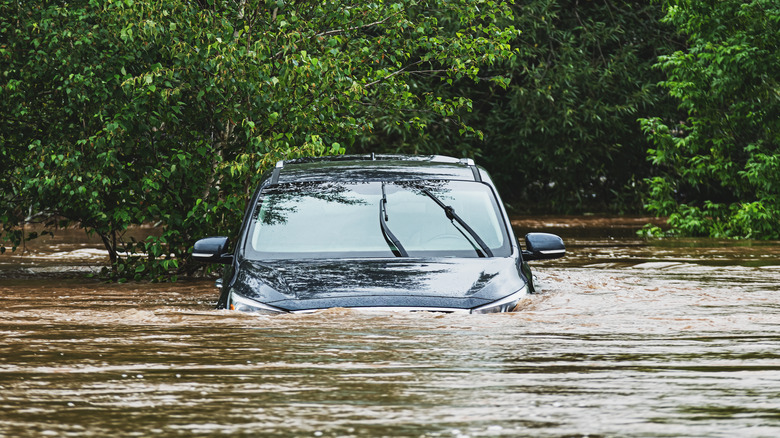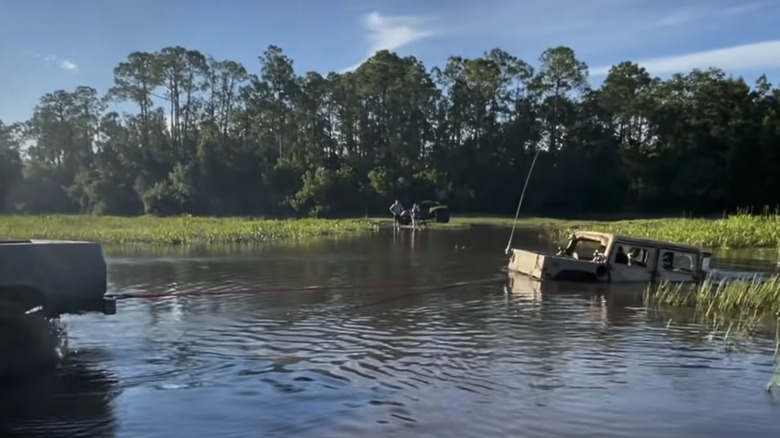Can You Actually Flood A Diesel Engine? Here's What You Need To Know
Military vehicles such as Humvees are often seen wading through water without much trouble, which gives diesel engines a reputation for being nearly indestructible. While they are tough and generally more durable than petrol engines, that doesn't mean they're immune to water-related damage. As we've explained before, it's best to avoid driving diesel trucks underwater, just like vehicles with petrol engines. Diesel engines are particularly vulnerable to a condition called hydrolock, when water enters the air intake and fills the combustion chamber. Water doesn't compress, so the engine seizes, bending rods, cracking blocks, or even wrecking the entire engine. Moreover, due to their tighter combustion chamber clearances and higher compression ratios, diesels require a smaller amount of water to hydrolock. Vehicles such as military trucks avoid this with snorkels and full waterproofing, but your average pickup or SUV is susceptible.
Beyond water, there are mechanical and fuel-related issues that can cause starting difficulties or performance problems. These resemble what's commonly called "flooding" in gasoline engines. Now, diesel engines don't use spark plugs and rely on compression ignition, so this term isn't usually applied to them, though similar symptoms can occur. Let's take a look at the factors that can cause issues.
Common causes of diesel engine flooding you should watch for
Again, diesel engines have their own set of quirks that, under the right (or wrong) conditions, can cause the combustion chamber to fill with unburned fuel and cause "flooding." One of the leading culprits is leaky fuel injectors. If your injectors drip fuel when the engine is off, that fuel pools in the cylinder, setting the stage for hard starts or a rough idle. Cold starts are another major contributor. In low temperatures, diesel fuel struggles to vaporize, and that liquid fuel can hang around unburned. If you try to start it over and over, things just get worse.
Sensor failures complicate matters. A faulty mass airflow sensor or other ECU component might instruct the engine to dump more fuel than it should. Clogged air filters also mess with the air-to-fuel ratio, causing incomplete combustion that leaves unburned diesel behind. Overfueling, either from mechanical faults or poor tuning, is another potential disaster. Too much diesel and not enough air equals combustion failure and flooded cylinders.
Pumping the accelerator before ignition is another practice that can lead to flooding. While this doesn't affect most modern diesel engines, which use electronic throttle controls, repeated starting attempts can still worsen overfueling problems. Combine any of these with stalling and an immediate restart attempt, and you've got a recipe for flooding — even with water out of the equation.
What happens when a diesel engine floods
As for what exactly happens when your diesel engine floods, for starters, don't expect it to fire up easily. You'll likely face hard starting, especially on cold mornings. If the engine does turn over, brace for plumes of white smoke due to unburned diesel vaporizing in the exhaust. Longer-term issues are more serious. If flooding happens frequently, excess diesel can reduce lubrication and increase wear within cylinder walls in a process known as cylinder washing. Any reduction in that protective layer of oil leads to increased metal-on-metal contact, which accelerates wear and leads to costly repairs.
Preventing these problems boils down to smart habits and regular maintenance. Keep injectors and sensors in top shape, change out dirty air filters, and follow proper cold-start protocols. Avoid over-cranking and use only high-quality, water-free diesel fuel. Additionally, if you live in a cold or humid climate, check your fuel for water contamination regularly.


